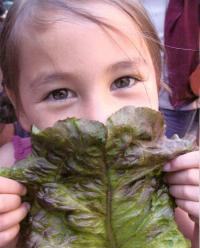"Healthy School Food and Hands-On Learning in the Garden"

John Muir School
School Contact Information
Gregory John, Administrator John Muir School, Berkeley Elementary (K-5), Public
The Green School Story
We addressed these 4 Pillars of a Green School
- Use Resources Sustainably
- Create Green Schoolyards and Serve Healthy Food
- Teach Stewardship & Student Action
We have taken these steps from the 7 Steps to a Green School
- Develop an action plan
- Integrate into the curriculum
- Monitor progress
- Involve, inform, and celebrate with the community
Environmental Challenge or Goal Addressed
John Muir School wanted to teach kids about healthy eating while greening the school campus.
Our Green School Approach
In the past seven years, the school has built an amazing educational garden and has been rethinking school lunch. As each year progressed, the garden continued to expand and encroach upon the campus allowing for an exciting type of outdoor and hands-on learning to grow in the minds and hearts of the children.
Changes and Benefits We've Achieved
In 2004, John Muir became part of the School Lunch Initiative. Changes were made to promote healthier, fresher food as part of the school lunch, and to reduce the garbage and waste associated with the food service program. A comprehensive recycling system is in place that allows them to separate waste into three groupings: food waste, plastic/metal, and landfill.
John Muir also is lucky to have a creek running through its property and we organize a creek clean-up.
Our school is also a pick-up site for the local, organic Community Support Agriculture (CSA) Box provided by Full Belly Farm.
Our Team
School District, Center for Ecoliteracy, Chez Panisse Foundation, Children's Hospital of Oakland Research Institute, parents, teachers, students
How We Involved Students
The first years saw the completion of a multi-terraced garden built solely by the hands of kindergarten-through-fifth graders.
Each classroom has time each week with either garden coordinator, Jasper Eiler, or Chef Carrie Orth, for hands-on learning about food. Every child at the school helps prepare the soil, sow seeds, tend the plants and harvest the crops.
Whether this experience will influence the food choices children will make over the longer term is one of the questions the University of California’s Center for Weight and Health is examining. The fourth and fifth graders at John Muir School, along with three other schools in the Berkeley Unified School District, took a survey about food opinions and choices. The kids kept a food diary for three days, writing down everything they ate and the amounts. The children in the study will participate for two more years and the information collected will be used to evaluate the impacts of the School Lunch Initiative.
Our Timeline for Change
6-8 years and ongoing.
Resources We Used
Center for Ecoliteracy
Berkeley Unified School District
Chez Panisse Foundation
Children's Hospital Oakland Research Institute School Lunch Initiative
Grant from the California Nutrition Network (through USDA)
Our Inspiration and Motivation
The kids have learned so much so fast. They loved to be in the garden, and learned quickly to love their vegetables. Hands-on learning has been inspiring to students and teachers alike: renowned educator, John Dewey, said: “Give the pupils something to do, not something to learn; and when the doing is of such a nature as to demand thinking, learning naturally results.”
Moving Forward
The next phase of the school’s environmental education effort will aim to address energy by examining the electricity needed to support the garden. To maintain the garden and cook the produce, various devices that need electricity to run are used, such as: electric burners for cooking food from the garden, juicers for “fruits & roots” lessons and tastings, blenders for making smoothies, power tools for building garden beds, and a radio for setting a serene environment for learning. Former garden teacher Michael Bush wanted to get a mobile solar unit to teach about solar power in their outdoor classroom and to provide electricity to run these tools. Not only will this new addition provide a safe source of energy, but children can directly witness and learn how the sun’s rays are turned into energy. Bush says “The solar unit will be a valuable addition to our garden, our study of photosynthesis, and our learning about alternative forms of energy in the 21st Century.”
Our Advice to Other Schools
Get lots of people and organizations involved! A grant from the California Nutrition Network, through the U.S. Department of Agriculture, supports the garden instructor position. Small grants from the Center for EcoLiteracy have supported the School Lunch Initiative, the development of the garden curriculum, and the construction of the garden. Michael has also raised other outside funds to pay for plants, garden materials, and tools. Students are also involved with an annual donations campaign, writing letters to local businesses to raise money for garden essentials and to raise awareness of the school’s goals for a healthy body, mind, and earth.
Tools to Share
The bell schedule has been changed so the children go to recess before lunch. Since they play first and eat second, without rushing to have enough time to play, there is less food waste. By the end of lunch nothing remains of the salad bar. The teachers now even eat lunch with their class.











